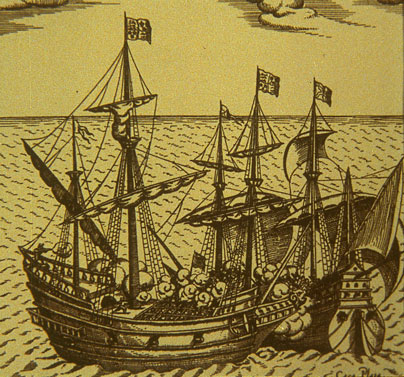
The oceans provided a spatial barrier that separated different ecosystems and cultures. This lasted from around 200 million years ago, when Pangaea split into separate continents, until man was able to conquer the oceans in the early 15 th century during the age of exploration. After Pangaea split, each continent was able to develop with limited interference from foreigners. The Mediterranean area saw one of the first and most documented interactions between separate communities via boats. In the 8 th century BCE, Homer documents the use of galleys, ships propelled by oars, in the Mediterranean. These ships enabled the Greeks to inhabit the islands in the Aegean and, later, the Romans to conquer their vast empire. The invention and technological advancements of the boat unified the world, enabling the technically advanced to impose themselves on virtually every community on the globe. European colonization transformed the Americas by changing the population and land, thus transforming the New World into their own world.
This revolutionary contact between the technically advanced Europeans and the more primitive societies in the Americas led to a confluence of previously separated organisms. The organisms that had the most affect on the Americas were the diseases that came with, and often before, the Europeans. The diseases were native to Eurasia, having evolved from domesticated animals such as the cow, horse, pig, and sheep. Through constant exposure to these germs, the Europeans were able to develop immunity to them (Diamond, 207-213.) But the populace in the Americas did not have these domesticated animals and so was not adapted to the diseases that the settlers brought with them. This caused a grave destruction of their population. In fact, during colonization, more Native Americans died from disease than actual battle (Diamond, 210.)
This was the “globalization of diseases” (Bewell.) There were many, they were fast, they affected some people while not others, and they caused the environment to adapt. It was diseases that made colonization of the Americas possible (Bewell, 8.) by weakening the Native Americans. Even before settlers arrived to discover new territory, the indigenous population could have been infected with disease because of its ability to spread from community to community in a short period of time (Bewell, 3.) This means that the Europeans often came across communities of sickly people with no apparent reason for their demise, making the Europeans feel innately superior. As William Bradford observed of the Connecticut River natives, “[They would] die like rotten sheep… by the marvelous goodness and providence of God not one of the English was so much as sick, or in the least measure tainted with this disease” (Bewell, 5.) The natives feared the strangers because of this death that came with them (Bewell, 7.) For the Europeans, disease became a power that was naturally wielded so well that from the 15 th to the 17 th centuries, the New World population declined by 50-95% (Bewell, 4 & 48.) Epidemic disease was the major weapon that Europeans unknowingly used to invade the Americas (Ehlrich, 254.), and enabled them to destroy the Native Americans and inhabit their land. And so it was that human travel by the Europeans changed the environment of the Americas by dramatically altering the population.
Along with diseases, Europeans introduced other organisms, such as Old World plants and animals, which changed the landscape of the New World. They also took New World plants and animals back to Europe, including people. With steel swords, guns, and horses, European troops of a few dozen were able to defeat Native American armies numbering in the thousands (Diamond, 3.) Continuing their domination, Europeans also imposed new ways of living and interacting with the environment on the American populations. “Europeans attempted to transpose their own biosocial ecologies to other regions of the globe” (Bewell, 48.) In Pennsylvania, for instance, settlers cleared the forests and built millponds, which caused the spreading of yellow fever to the Native Americans. The settlers thought the natives’ illness was temporary, believing that in time they would adapt to the European way of life. The settlers even compared the natives’ adaptation to millponds and yellow fever to their own ability to adapt to the changing seasons.
Sea travel transformed the entire world, mixing previously separated biosocial ecologies. Through technology and the ability to sail across seas, the world became a smaller place, which meant that suddenly cultures were able to influence one another. The presence of Europeans dramatically influenced the environment of the New World and forever changed the local population.
The natives didn’t have the technology of ships that would allow them to make it across the ocean. So did that make the Europeans right in feeling superior? Diamond says that the Europeans were not innately superior to the Native Americans but rather their prosperity was due to their geographic location. The United States has been able to influence and dominate the current world because of our technology. This also leads us to feel a sense of superiority like the Europeans did. Will we be undone by our hubris like past superpowers?
Bewell, Alan. Romanticism and Colonial Disease. Baltimore; London: Johns Hopkins University Press, 1999.